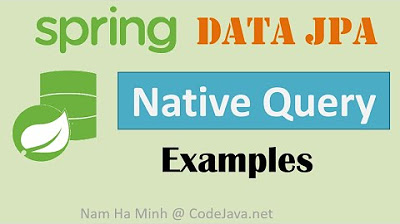Learn SQL + Database Concepts in 20 Minutes
Summary
TLDRThis video tutorial provides an introduction to SQL and its role in data analysis, specifically focusing on how to filter and work with dates in SQL queries. The instructor explains the importance of understanding both date and time values in a database and demonstrates methods to filter rental data based on specific date ranges. Two approaches are covered: using precise date-time conditions or extracting the date portion using SQL functions. The video concludes with a preview of more advanced SQL concepts for data analysis in future lessons.
Takeaways
- 😀 A database is a place where data is stored, organized, and retrieved to solve business problems.
- 😀 SQL (Structured Query Language) is the language used to communicate with databases and manage data through CRUD operations: Create, Read, Update, and Delete.
- 😀 In the data analysis profession, most of the work involves reading and analyzing data, making SQL's 'Read' operation the most relevant.
- 😀 A typical database is made up of tables, where each table holds information about specific entities (e.g., DVDs, customers, rentals).
- 😀 Databases help avoid redundancy by linking related data across multiple tables using IDs (e.g., customers sharing the same address).
- 😀 Database Management Systems (DBMS) such as MySQL, SQL Server, Oracle, and PostgreSQL manage databases and allow interaction using SQL.
- 😀 The 'sakila' sample database, a fictional DVD rental business, is used to practice SQL queries in MySQL, providing a realistic scenario for data analysis.
- 😀 SQL queries like 'SELECT' can retrieve data, with flexibility to specify what data to show (e.g., specific columns or filtered results).
- 😀 You can filter results in SQL using the 'WHERE' clause, allowing for operations like searching for specific words in a field (e.g., titles starting with 'love').
- 😀 SQL allows sorting of data with the 'ORDER BY' clause to organize results in ascending or descending order based on specific columns.
- 😀 SQL queries can also work with date ranges, using conditions like 'BETWEEN' and functions like 'DATE()' to filter by dates and times effectively.
Q & A
What is SQL and why is it important for data analysis?
-SQL (Structured Query Language) is a programming language used to manage and manipulate relational databases. It is essential for data analysis because it allows analysts to query, filter, and process large datasets efficiently, extracting meaningful insights.
What is the main purpose of the DVD rental business example in the script?
-The DVD rental business example is used to explain how a database is structured with tables containing data like customers, films, and rentals. It helps to demonstrate how SQL can be used to retrieve, filter, and organize data from these tables.
How are tables structured in a database?
-Tables in a database are structured in rows and columns. Each row represents a record, while each column represents a field of data. For example, a 'customer' table might include columns like 'customer_id', 'name', and 'email'.
What are some key SQL functions used to filter and organize data?
-Key SQL functions used to filter and organize data include the 'SELECT' statement to choose the fields, the 'WHERE' clause to apply conditions, 'ORDER BY' to sort the data, and functions like 'COUNT()' and 'SUM()' to aggregate data.
Why is the 'WHERE' clause important in SQL?
-The 'WHERE' clause is important because it allows you to filter data based on specific conditions. This is crucial when you want to retrieve only the data that meets certain criteria, such as rentals that occurred after a specific date.
What is the significance of date and time handling in SQL queries?
-Handling date and time correctly in SQL queries is important because data can be stored with specific time values. If not considered properly, it can lead to incorrect or incomplete results, such as failing to include rentals within a specific time frame.
What are two ways to solve the issue of date and time filtering in SQL?
-The first way is to specify both the start and end time within the query, using values like '00:00:00' for the start and '23:59:59' for the end. The second way is to use a SQL function like 'DATE()' to convert a datetime value into just the date portion for simpler filtering.
What does the 'DATE()' function do in SQL?
-The 'DATE()' function in SQL is used to extract only the date portion from a datetime value. This simplifies queries by removing the time part and making it easier to filter or group data based on just the date.
How can SQL be used for data analysis in practice?
-SQL can be used for data analysis by querying databases to extract relevant data, performing aggregations like summing or averaging, and filtering data based on various conditions. It allows analysts to make data-driven decisions by presenting the information in a clear, structured way.
What are some advanced SQL concepts that are mentioned for future learning?
-Advanced SQL concepts that will be covered in future lessons include more complex queries, joins to combine data from multiple tables, subqueries for nested queries, and advanced data manipulation techniques like grouping and window functions.
Outlines

此内容仅限付费用户访问。 请升级后访问。
立即升级Mindmap

此内容仅限付费用户访问。 请升级后访问。
立即升级Keywords

此内容仅限付费用户访问。 请升级后访问。
立即升级Highlights

此内容仅限付费用户访问。 请升级后访问。
立即升级Transcripts

此内容仅限付费用户访问。 请升级后访问。
立即升级浏览更多相关视频

23 - T-SQL - OUTER JOINS - LEFT e RIGHT - Selecionar dados de várias tabelas - SQL Server

Spring Data JPA Native Query Examples

Olympic Data Analytics | Azure End-To-End Data Engineering Project | Part 2

Composable Queries with DuckDB

Power BI Project For Beginners | Sales Insights Data Analysis Project - 3 - Data Analysis Using SQL

SQL Explained in 100 Seconds
5.0 / 5 (0 votes)
